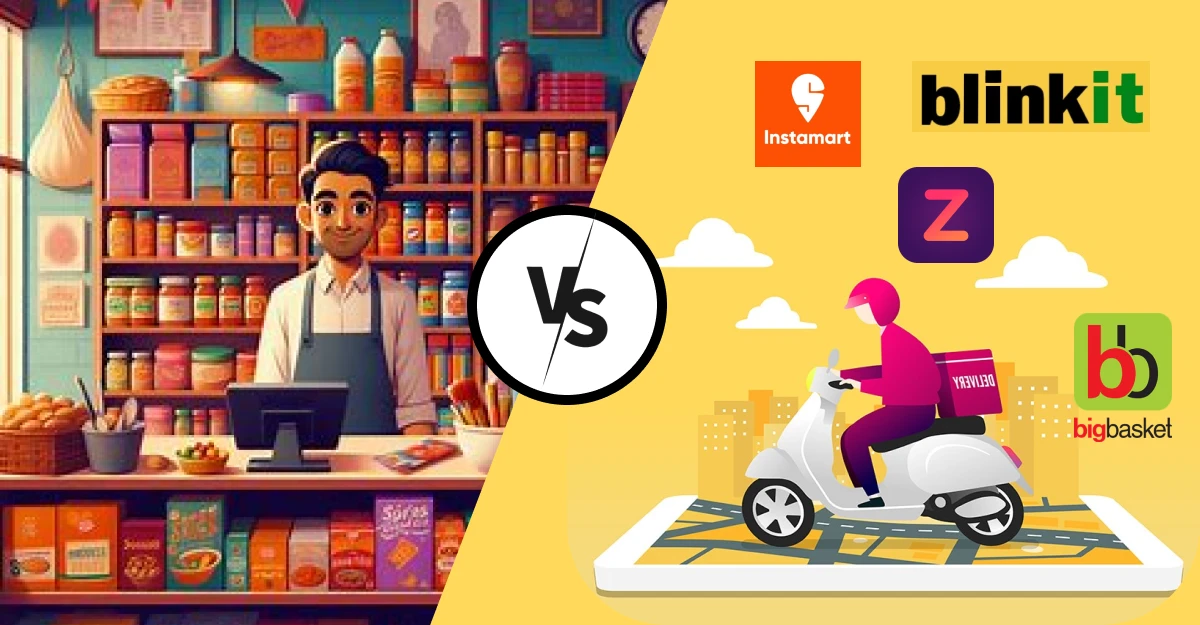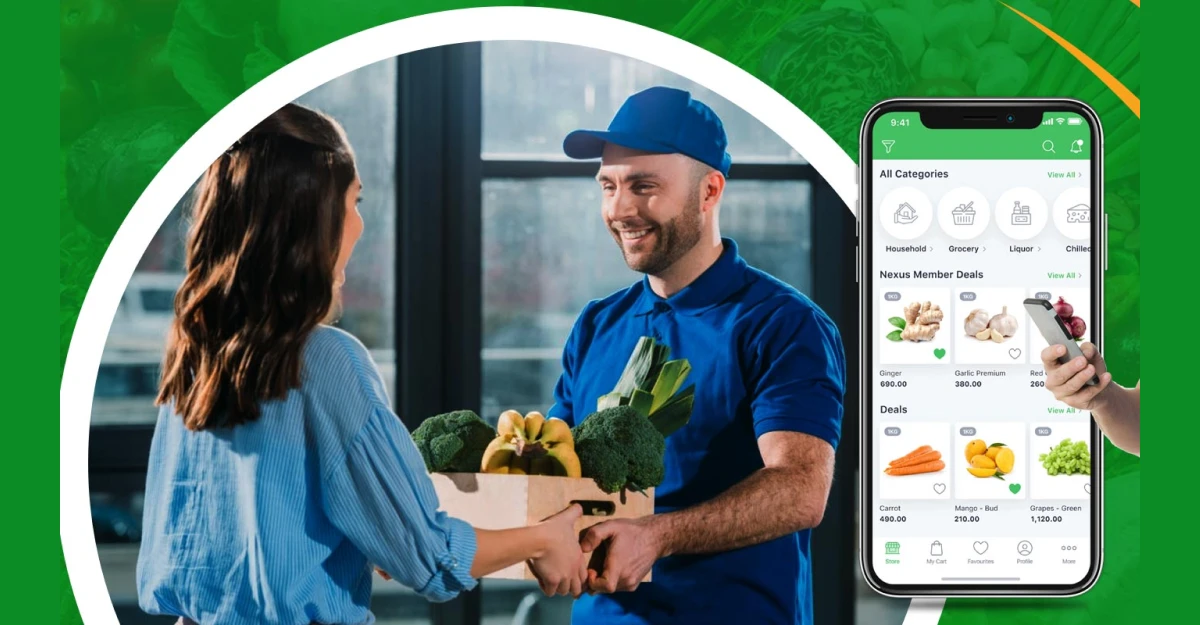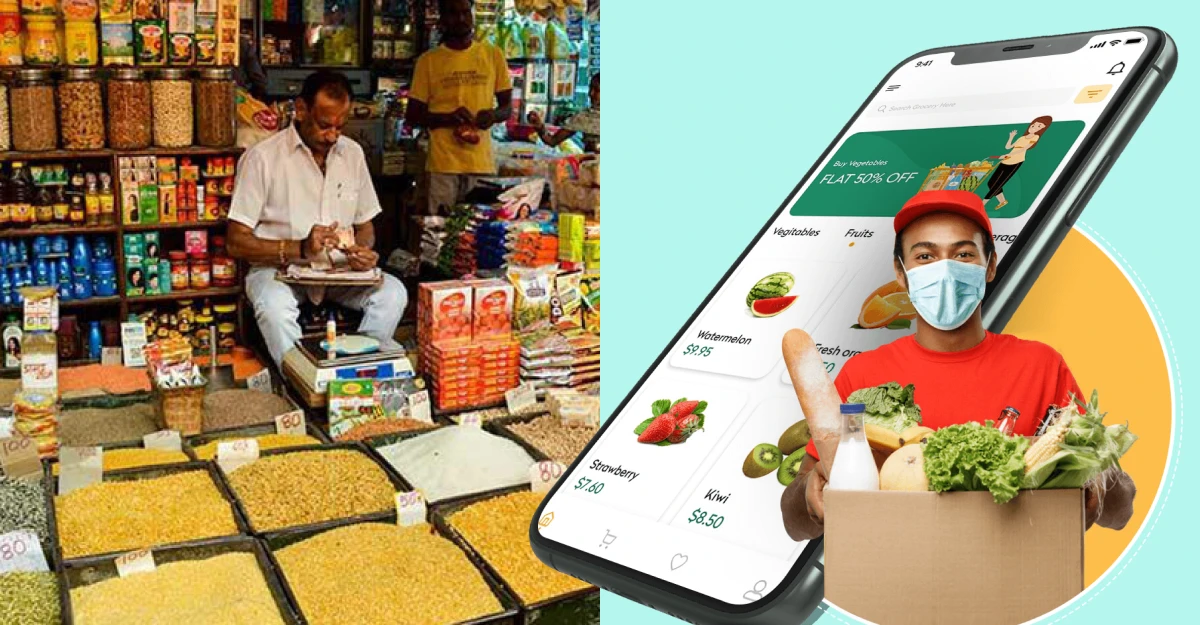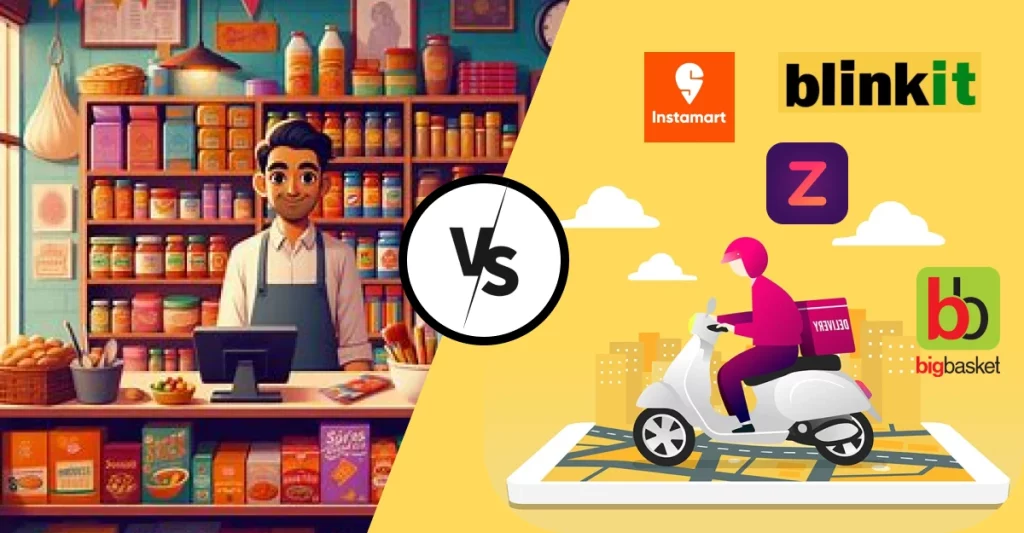With the rapid boom of grocery delivery apps like Swiggy, Zepto, Blinkit, Bigbasket, etc. emerged; everyone thought “Who would go downstairs to small Kirana stores to buy groceries when the groceries can arrive at your doorstep?”
But see, the small Kirana stores are still operating well.
Everything seems normal but the clash between small Kirana stores vs Swiggy, Zepto, & Blinkit has already begun.

How?
Imagine your local Kirana store, where the shopkeeper knows you by name and always has what you need. Now, picture the convenience of ordering groceries with a tap on your phone and having them delivered in minutes by Swiggy, Zepto, or Blinkit. This is the fascinating clash of tradition and technology happening in India’s retail world.
You might wonder, can these beloved neighborhood stores and speedy delivery services both survive in this competitive market?
Let’s dive into their strengths, challenges, and potential for coexistence, uncovering what the future holds for how you shop groceries!
(A) Demographics & Consumer Preferences: Local Kirana Store vs Grocery Delivery
We will begin our discussion by going through the facts revealed by various surveys.
(A.1) Overall Data
Let’s begin with the YouGov survey. You’ll be surprised to know that urban Indians prioritize shopping from grocery stores over delivery apps!
Wait, what?
Yes, they studied a sample of 3,000 respondents for two weeks in the year 2021, when grocery delivery peaked due to the COVID-19 pandemic.
Here’s what they found (YouGov Survey)–
- Shopping from Local Kirana Store: 58%
- Grocery Delivery: 42%
Now, let’s look at another survey conducted by Axis My India SCI Survey of 2022. Their sample included 10,207 respondents with 70% urban India population and 70% rural area population. Their results were more shocking-
- Shopping from local Kirana stores: 86%
- Grocery Delivery: 2%
Didn’t Flipkart recently announce its entry into the quick commerce market focussed on grocery delivery?
Yeah! It is true…
Even Uber and JioMart (Reliance Retail) entered the grocery delivery segment too…
Why would these grocery delivery apps expand rapidly if a majority of people don’t prefer online grocery delivery? You see, there is a flip side too!
(A.2) Stats Presented by the Grocery Delivery Apps
Now, let’s dive into the number of users and market share of various grocery delivery apps.
| Online Delivery Apps | Google PlayStore Downloads (Installs) | Monthly Active Users (MAU) | Market Share |
| Swiggy Instamart | 10 Cr+ (Swiggy App) | 17-18 million | 27% |
| Zepto | 1 Cr+ | 16-17 million | 21% |
| Blinkit | 5 Cr+ | 23-24 million | 45% |
| BigBasket | 5 Cr+ | 9-11 million | 7% |
| JioMart | 5 Cr+ | 11 million | 4% |
As you can see, Blinkit stands tall in terms of monthly active users and market share. Although the number of installs from Google PlayStore serves as an indicator of the total number of users. But you must not forget the two key facts here-
- Swiggy Instamart is not a separate app but a key feature of “Swiggy App” due to which the 10 Cr+ downloads represent Swiggy users who may use Swiggy Instamart as well.
- The total number of users can be more than the ones represented in the column of “Total Installs” because it includes only the ones from Google PlayStore. The Apple store users aren’t mentioned therefore the data was unavailable.
(A.3) Analysing the Data
You’ll find that local Kirana shops are still the top choice for most Indians. A 2021 YouGov survey showed that 58% of urban shoppers preferred these stores, while only 42% used delivery apps. Even more striking, a 2022 Axis My India survey revealed that 86% of people chose local Kirana stores, with just 2% opting for delivery apps.
However, don’t count out the delivery apps just yet.
Apps like Blinkit, Swiggy Instamart, Zepto, BigBasket, and JioMart have millions of users, especially in metro cities. These companies are betting big in the metro cities which is currently dominated by youngsters and IT professionals.
So, while Kirana shops are still king, delivery apps are quickly gaining popularity in bustling tier-1 cities!
(B) Competition: Small Kirana Stores vs Grocery Delivery Apps
Let’s compare them side by side-
| Aspects | Small Kirana Stores | Grocery Delivery Apps |
| Majority of User Base | Predominantly rural and urban | Mostly metro cities |
| Convenience | Immediate purchase, personalized service | Home delivery, wide variety, 24/7 access in most cases |
| Reach | Local neighborhoods | Broad, but primarily in urban and metro areas |
| Market Penetration | Established, long-standing presence | Rapidly growing, but still expanding |
| Popular Platforms | Individual, local shops | Blinkit, Swiggy Instamart, Zepto, BigBasket, JioMart |
| Technology Use | Minimal, traditional methods | High, app-based services |
| Customer Interaction | Direct, face-to-face | Indirect, through apps |
| Product Range | Limited to local inventory | Extensive, can offer products not locally available |
| Business Model | Family-owned, small-scale | Corporate-owned, large scale |
(C) Advantages offered by Small Kirana Stores over Grocery Delivery Apps
When you think about where to buy your groceries, small Kirana stores have some clear advantages over grocery delivery apps. Let’s see why you might prefer these local shops-
- Personal Touch: First, there’s the personal touch. At your local Kirana store, the shopkeeper knows you by name. They remember your regular orders and might even offer recommendations or special discounts. This personalized service is something that apps can’t match.
- Immediate Purchases: Next, consider the convenience of immediate purchases. When you need something urgently, like an ingredient you forgot for dinner, you can just walk to the nearby Kirana store and get it instantly. There’s no waiting for delivery slots or worrying about the delivery being delayed.
- Trust & Reliability: Another big plus is trust and reliability. You’ve probably built a relationship with your local shopkeeper over the years. You know they provide fresh and good-quality products. If there’s ever an issue with a product, you can address it directly and get it resolved on the spot.
- No Delivery Fee & Ease in Purchasing Small Stuff: Kirana stores also cater to your small, frequent needs. If you need just one item, like a packet of milk or a loaf of bread, it’s much easier to grab it from the local store rather than placing a small order online and waiting for delivery.
- Payment Flexibility: This is another benefit. While delivery apps usually require digital payments, your local Kirana store will accept cash, and they might even let you pay later if you’re a regular customer.
- Community Building: Shopping at local stores helps support small businesses in your neighborhood, contributing to the local economy. This communal aspect is something that online shopping can’t provide.
While delivery apps are convenient, these local stores have a special place in your everyday life.
(D) Advantages offered by Grocery Delivery Apps over Small Kirana Stores

When it comes to grocery shopping, grocery delivery apps have some standout advantages over small Kirana stores. Let’s go through the advantages of Grocery Delivery Apps-
- Convenience: First, there’s the convenience factor. With grocery delivery apps, you can shop anytime, anywhere. Whether you’re at home, at work, or even on the go, all you need is your smartphone. You don’t have to worry about store hours or making a trip to the store. This is perfect for busy schedules.
- Wide Variety: Next, think about the variety. Delivery apps offer a wide range of products, often more than what your local Kirana store can stock. You can find specialty items, international brands, and even organic products that might not be available locally. This extensive selection makes it easy to find everything you need in one place.
- Filter Options, Product Info & Reviews: The apps also often feature user-friendly interfaces with search and filter options, making it easy to find specific items quickly. Plus, many apps provide detailed product information and reviews from other customers, helping you make informed choices.
- Discounts & Promotions: Price and promotions are another big plus. Delivery apps frequently offer discounts, deals, and cashback offers that can help you save money. They also have the option to compare prices easily, so you know you’re getting the best deal without hopping from store to store.
- Delivery Timings: Scheduled deliveries add another layer of convenience. You can choose a delivery time that suits your schedule, ensuring that you’re home to receive your groceries. Some apps even offer quick delivery options, bringing your order to your door in under an hour.
- Various Payment Methods: Digital payments make the transaction process smooth and hassle-free. You can pay using various methods like credit cards, digital wallets, or UPI, reducing the need for cash handling. Many apps also save your payment details, speeding up the checkout process.
- Order Tracking: Finally, tracking your order in real-time lets you know exactly when your groceries will arrive, adding a level of certainty and planning ease that traditional shopping can’t offer.
These features make online delivery apps a popular choice, especially for those who value ease and efficiency in their shopping experience.
(E) Challenges Faced
Although both the segments i.e. Kirana stores and grocery delivery apps have their own challenges. But here we will look at some of the common challenges they face so that we can come up with an effective solution-
| Challenges | Small Kirana Stores | Grocery Delivery Apps |
| Limited Reach | Limited geographical reach, serving only local neighborhoods. | Need to establish infrastructure and logistics to cover a broader customer base, especially in remote or rural areas. |
| Competition | Facing stiff competition from larger supermarkets and chain stores. | Competing with multiple other delivery apps, each vying for market share and customer loyalty. |
| Inventory Management | Limited storage space and inventory management skills, leading to stockouts or overstocking. | Need to manage extensive inventory efficiently to ensure timely delivery and prevent wastage. |
| Technology Adoption | Reluctance or inability to adopt technology for inventory management, ordering, and customer engagement. | Requires continuous investment in technology to improve user experience, optimize operations, and stay competitive. |
| Delivery Challenges | Lack of delivery infrastructure and resources makes home delivery difficult or costly. | Establishing a reliable delivery network, managing delivery personnel, and ensuring timely and efficient delivery. |
| Customer Engagement | Limited avenues for customer engagement and retention, relying mainly on personal relationships and word-of-mouth. | Need to invest in digital marketing, loyalty programs, and customer support to attract and retain customers. |
| Financial Constraints | Limited access to capital and funding, hindering growth and expansion opportunities. | Requires significant investment in technology, marketing, and infrastructure to scale operations and compete effectively. |
| Adaptability to Change | Resistance to change and reliance on traditional business models may impede adaptation to evolving market trends. | Need to continuously innovate and adapt to changing consumer preferences, technological advancements, and market dynamics. |
So, these are some of the major obstacles that both segments face while running their businesses.
(F) Opportunities for Collaboration: Can they all survive?

As you have read above, small Kirana stores and online grocery delivery apps have distinct strengths and challenges. However, there are ample opportunities for collaboration. By effectively using each other’s strengths, they can create mutually beneficial partnerships that enhance customer experience and drive business growth. Here’s how-
(F.1) Potential for Kirana Stores to Partner with Delivery Services
One significant opportunity lies in Kirana stores partnering with delivery services. These partnerships can help Kirana stores extend their reach beyond their local neighborhoods and tap into a larger customer base.
By joining forces with delivery apps, Kirana stores can offer home delivery services, meeting the growing demand for convenience among consumers.
These partnerships also allow Kirana stores to benefit from the delivery apps’ technology infrastructure and logistics expertise. They can leverage the apps’ digital platforms for online ordering and payment processing, streamlining the shopping experience for customers.
(F.2) Adoption of Technology by Kirana Stores to Improve Operations
To capitalize on these opportunities, Kirana stores need to embrace technology to improve their operations. This includes adopting inventory management systems, digital payment solutions, and online ordering platforms.
By taking help from online delivery apps for digitizing their operations, Kirana stores can enhance efficiency, reduce costs, and better serve their customers.
Moreover, technology adoption enables Kirana stores to gather valuable data on customer preferences and purchasing patterns. This data can inform inventory decisions, marketing strategies, and personalized promotions, driving customer loyalty and revenue growth.
(F.3) Using Kirana Stores as Dark Stores by Grocery Delivery Apps for Mutual Benefits
Another innovative approach is for grocery delivery apps to utilize Kirana stores as dark stores. Dark stores are fulfillment centers that exclusively serve online orders, allowing for faster order processing and delivery. By converting Kirana stores into dark stores, delivery apps can leverage their existing infrastructure and inventory to fulfill online orders more efficiently.
(G) Future Outlook: Example
One live example of this strategy is Flipkart’s plan to transform Kirana stores into dark stores. Flipkart aims to partner with Kirana stores to fulfill its online grocery orders, leveraging their proximity to customers and existing inventory. This collaboration benefits both parties, as Kirana stores gain additional revenue streams and delivery apps improve their fulfillment capabilities.
We have explained it in detail here- Flipkart’s entry in grocery delivery service.
In a nutshell, the collaboration between Kirana stores and grocery delivery apps presents exciting opportunities for growth and innovation.
(H) Ending Note
Coming to the question “Small Kirana Stores vs Swiggy, Zepto & Blinkit: Can they all survive?” So the answer is- Yes! Both of them can survive if they collaborate with each other for better outcomes!
By the way, what do you think about this? Don’t forget to share your thoughts in the comment section below!

